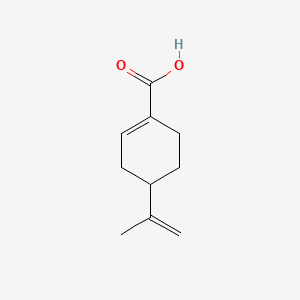| MeSH term | MeSH ID | Detail |
|---|---|---|
| Prostatic Neoplasms | D011471 | 126 associated lipids |
Perillic acid
Perillic acid is a lipid of Prenol Lipids (PR) class. The involved functions are known as Membrane Potential, Mitochondrial, Neuroprotection, inhibitors, Protein Geranylgeranylation and mitochondrial depolarization. Perillic acid often locates in Membrane and Extracellular. The associated genes with Perillic acid are RAB3A gene and neutrophil cytosol factor 67K.
Cross Reference
Introduction
To understand associated biological information of Perillic acid, we collected biological information of abnormalities, associated pathways, cellular/molecular locations, biological functions, related genes/proteins, lipids and common seen animal/experimental models with organized paragraphs from literatures.
What diseases are associated with Perillic acid?
There are no associated biomedical information in the current reference collection.
Possible diseases from mapped MeSH terms on references
We collected disease MeSH terms mapped to the references associated with Perillic acid
PubChem Associated disorders and diseases
What pathways are associated with Perillic acid
Lipid pathways are not clear in current pathway databases. We organized associated pathways with Perillic acid through full-text articles, including metabolic pathways or pathways of biological mechanisms.
Related references are published most in these journals:
| Pathway name | Related literatures |
|---|
PubChem Biomolecular Interactions and Pathways
Link to PubChem Biomolecular Interactions and PathwaysWhat cellular locations are associated with Perillic acid?
Visualization in cellular structure
Associated locations are in red color. Not associated locations are in black.
Related references are published most in these journals:
| Location | Cross reference | Weighted score | Related literatures |
|---|
What functions are associated with Perillic acid?
Related references are published most in these journals:
| Function | Cross reference | Weighted score | Related literatures |
|---|
What lipids are associated with Perillic acid?
There are no associated biomedical information in the current reference collection.
What genes are associated with Perillic acid?
Related references are published most in these journals:
| Gene | Cross reference | Weighted score | Related literatures |
|---|
What common seen animal models are associated with Perillic acid?
There are no associated biomedical information in the current reference collection.
NCBI Entrez Crosslinks
All references with Perillic acid
Download all related citations| Authors | Title | Published | Journal | PubMed Link |
|---|---|---|---|---|
| Choy WY et al. | Role of mitogen-activated protein kinase pathway in acetylcholine-mediated in vitro relaxation of rat pulmonary artery. | 2002 | Eur. J. Pharmacol. | pmid:11755166 |
| Seto SW et al. | Modulatory effect of interleukin-1beta on rat isolated basilar artery contraction. | 2006 | Eur. J. Pharmacol. | pmid:16438962 |
| Wu CS et al. | Terpinen-4-ol Induces Apoptosis in Human Nonsmall Cell Lung Cancer In Vitro and In Vivo. | 2012 | Evid Based Complement Alternat Med | pmid:21760828 |
| Cheng QF et al. | Effect of perillic acid, a putative isoprenylation inhibitor, on the cultured rat lens. | 2001 | Exp. Eye Res. | pmid:11446774 |
| Omoigui S | The Interleukin-6 inflammation pathway from cholesterol to aging--role of statins, bisphosphonates and plant polyphenols in aging and age-related diseases. | 2007 | Immun Ageing | pmid:17374166 |
| Del Toro-Arreola S et al. | Effect of D-limonene on immune response in BALB/c mice with lymphoma. | 2005 | Int. Immunopharmacol. | pmid:15778119 |
| Saldanha SN and Tollefsbol TO | The role of nutraceuticals in chemoprevention and chemotherapy and their clinical outcomes. | 2012 | J Oncol | pmid:22187555 |
| Ikechukwu Ezennia E et al. | Analysis of perillic acid in plasma by reversed-phase high-performance liquid chromatography with ultraviolet detection. | 1997 | J. Chromatogr. B Biomed. Sci. Appl. | pmid:9061476 |
| Pratheeshkumar P et al. | Protective role of perillic acid against radiation-induced oxidative stress, cytokine profile, DNA damage, and intestinal toxicity in mice. | 2010 | J. Environ. Pathol. Toxicol. Oncol. | pmid:21303327 |
| Mukherjee A et al. | 6-Nitro-2-(3-hydroxypropyl)-1H-benz[de]isoquinoline-1,3-dione, a potent antitumor agent, induces cell cycle arrest and apoptosis. | 2010 | J. Exp. Clin. Cancer Res. | pmid:21194464 |
